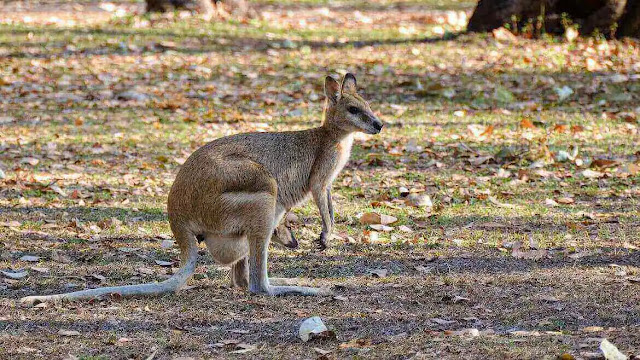Wallaroo | The Unique Cross Between a Kangaroo and Wallaby
 |
| Wallaroo |
Let's briefly study Kangaroos and Wallabies before delving into Wallaroos.
Kangaroos and wallabies are marsupials that belong to the
same family Macropodidae. They share many similarities in terms of their
physical characteristics. Kangaroos are generally larger and heavier, while
wallabies are smaller and more agile. Kangaroos have a more upright posture
while hopping, and their legs are larger and more muscular than those of
wallabies. In contrast, wallabies have longer tails, larger ears, and shorter
legs. The diet of both animals consists mainly of vegetation, but kangaroos
prefer grass while wallabies feed on leaves and shrubs. While kangaroos are
often used as a symbol of Australia, wallabies are less known but equally fascinating
creatures.
What is a Wallaroo?
Wallaroos are marsupials belonging to the family
Macropodidae, which includes other marsupials such as kangaroos and wallabies.
Wallaroos are native to Australia, where they inhabit grassy plains, rocky
outcrops, and wooded areas. They are in-between size-wise, with males weighing
up to around 100 pounds while females are somewhat smaller.
Appearance and Characteristics
Wallaroos have both kangaroo and wallaby-like features. They
have a stocky body, powerful legs like a kangaroo, and a broad head, short ears
like a wallaby. Wallaroos have short and thick silky fur, and their coloring
ranges from reddish-brown to grey.
Wallaroo behavior and diet
Wallaroos are primarily nocturnal and are active in the
early hours of the evening until dawn. They are social animals that live in
groups or mobs of up to 50 individuals. They are herbivores and consume various
types of vegetation, including grasses, leaves, and shrubs.
Breeding
Wallaroos are marsupials, which means females give birth to
underdeveloped young called joeys. The joey spends several months developing in
its mother's pouch before it begins to emerge and explore the world outside.
Wallaroos are polygamous, and their social hierarchy is based on size, age, and
strength.
Conservation Status
Wallaroos are not considered a threatened species, but they
are protected by law in Australia. The main threat to wallaroos is habitat loss
due to human activities such as mining and farming. Climate change is also a
concern, particularly in areas where wallaroos are already on the edge of their
ranges.
In conclusion, wallaroos are amazing creatures with unique
characteristics and behaviors that fall somewhere between a kangaroo and wallaby.
With their distinct features and important role in their habitat, wallaroos are
a reminder of the beauty and diversity of the natural world. While they may be
less well-known than their kangaroo and wallaby cousins, Wallaroos are just as
fascinating and worthy of our attention.




Please do not enter any spam link in the comment box